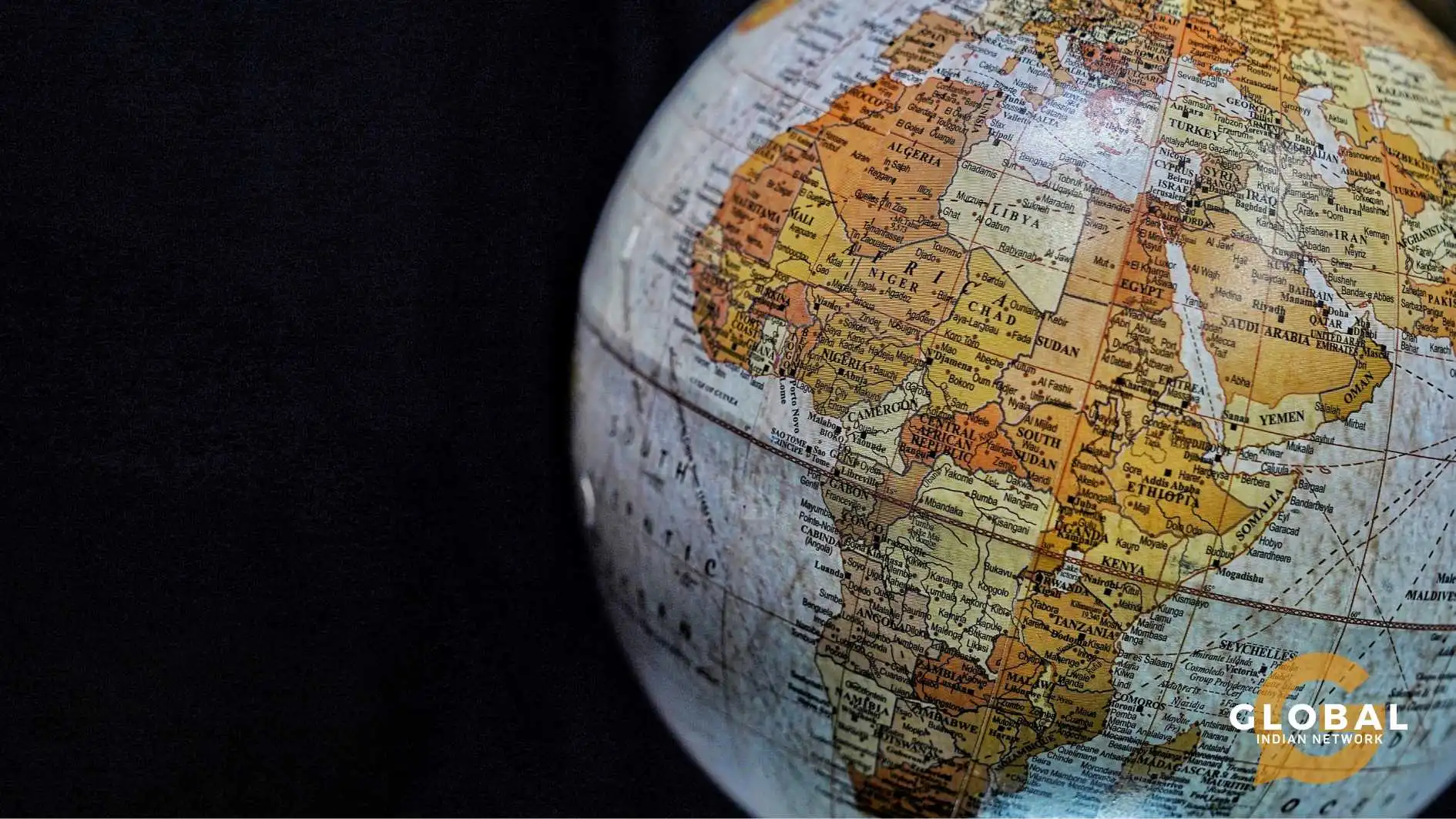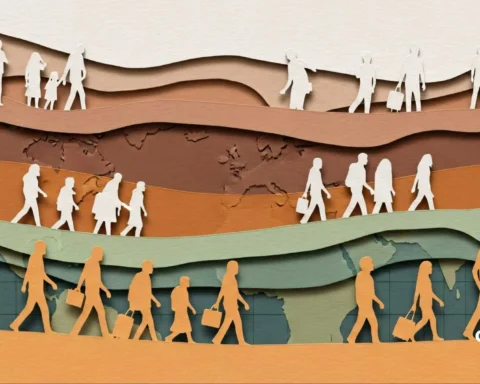In the bustling heart of East Africa, a new pulse is beating, a digital rhythm powered by bold innovation and cross-continental collaboration. Smartphones flicker in remote villages, seamless payment apps connect bustling city markets, and healthcare consultations leap across miles with a click. Behind this remarkable transformation stand two remarkable forces: the innovative spirit of East African entrepreneurs and the expertise of Indian tech giants and diaspora visionaries. Bound by shared histories and new ambitions, they are weaving together fintech marvels, e-commerce platforms, and digital health solutions that are rewriting the region’s economic story.
The result?
A vibrant ecosystem where a shopkeeper in Kampala can access microloans from Mumbai, and a patient in rural Tanzania consults a Nairobi-based doctor on an app powered by Indian software. This is East Africa’s digital leap – bold, inclusive, and boundary-breaking – setting the stage for a future where technology knows no borders.
Table of Contents
The Digital Ecosystem: Foundations for Growth
The East African Community (EAC) has a population of 174 million and a GDP of $163.4 billion, with over 1 billion consumers through the Common Market for Eastern and Southern Africa (COMESA), the Southern African Development Community (SADC), and the African Continental Free Trade Area (AfCFTA).
East African countries have expanded their 4G and 5G networks, boosting internet access and digital services. Infrastructure projects, such as Kenya’s “Digital Superhighway,” connect millions of people, supporting digital businesses and driving economic growth. Governments and regional partnerships promote innovation through harmonized e-transaction laws and interoperable digital payment systems.
East Africa is poised to outpace all other regions in Sub-Saharan Africa, with a projected GDP growth rate of 5.7% in 2025. Countries such as Rwanda, Ethiopia, Tanzania, Uganda, and Kenya are expected to show strong growth rates. Notably, Rwanda is projected to have the highest growth rate at 7.2%, followed by Ethiopia at 6.7%, Tanzania at 6.1%, Uganda at 6.0%, and Kenya at 5.4%.
East Africa’s Progress Toward a Digital Superhighway
Kenya: Leading the Charge
- Kenya’s Digital Superhighway strategy aims to expand high-speed internet, create jobs, and digitize public services. Plans include 25,000 public WiFi hotspots, 1,000 village digital hubs by 2027, affordable smartphones, and digitized government services, supported by international partners like China. 64% of East Africans have access to high-speed internet, but only 24% actively use it.
Regional Integration Underway
- The East Africa Regional Digital Integration Project (EA-RDIP), backed by the World Bank, is facilitating connectivity among countries such as Somalia, South Sudan, and Ethiopia, as well as with regional bodies like the East African Community (EAC) and the Intergovernmental Authority on Development (IGAD), to promote broadband connectivity.
Infrastructure & Policy Foundations
- The region is investing in fibre optic networks, satellite connectivity for remote areas, and legal frameworks for data protection and cybersecurity. Notably, mobile roaming charges have already been eliminated within the One Network Area (ONA) initiative.
Future Tech Integration
While the Digital Superhighway is already being implemented, it also serves as a foundation for future technologies, including:
- AI-powered data routing
- Quantum-safe encryption
- Edge computing for rural connectivity
- Smart city integration with IoT frameworks
Fintech: Expanding Access
East Africa’s digital economy, particularly in Kenya, is thriving due to strong mobile and internet penetration, which enables innovative financial services for unbanked and underbanked populations. The M-Pesa mobile money platform handled over $314 billion in 2023.
Indian technology firms, including Infosys, Tata Consultancy Services, Wipro, and Tech Mahindra, are providing banking infrastructure, payment gateways, cloud-based transaction processing, and risk management solutions to local banks and fintech startups. They have outperformed global competitors in high-profile IT deals, such as 4G Identity Solutions‘ role in the Kenyan elections and the rollout of biometric systems in the banking sector.
E-Commerce: Marketplaces Without Borders
East African e-commerce is flourishing due to internet literacy, mobile payments, and tech-savvy consumers. Local entrepreneurs and Indian IT companies are establishing online marketplaces that connect small businesses to global markets. The market is projected to generate $49.67 million in 2025, reaching $90.39 million by 2030, with China generating the most revenue, accounting for 7.0 million users.
Digital Health: Bridging Gaps, Saving Lives
East Africa’s health systems are transitioning from a reactive model to a proactive “wellness” approach, with Indian firms providing AI-driven platforms, integrated health IT solutions, and consultancy services in Kenya, Uganda, and Tanzania. The digital health market is projected to reach $1.23 billion by 2025, with Indian firms deploying AI-driven platforms in these regions.

The Diaspora Advantage
The African diaspora, comprising over 140 million individuals worldwide, is a significant catalyst for innovation in Africa. Entrepreneurs in East Africa support local startups by linking them to global markets, introducing diverse business models, and injecting capital and technical expertise. Remittances to Africa exceed $90 billion annually, fueling innovation and economic transformation.
Remittances in African countries like Kenya, Nigeria, and Ghana surpass FDI, with 75% going to household support. However, a growing share is being invested in startups, fintech platforms, and digital infrastructure, shifting diaspora capital from charity to equity.
Indians in East Africa, primarily in Kenya, Tanzania, and Uganda, make significant contributions to the region’s economy through investment, mentorship, and collaboration. They drive innovation in fintech, digital health, and e-commerce, leveraging India’s tech expertise to scale startups and build infrastructure—their capital shifts from philanthropy to equity.
Role of Global Indians
Global Indian men and women in diaspora networks mentor East African founders and co-develop platforms, serving as soft power bridges that connect Indian innovation with African development goals.
- Sunil Bharti Mittal, founder of Airtel, acquired Zain’s operations in Kenya, Uganda, and Tanzania, transforming East Africa’s telecom landscape by expanding mobile connectivity and money services, promoting digital inclusion, and fostering fintech growth.
- Ritesh Agarwal – Founder of OYO Rooms: OYO’s entry into East Africa, particularly Kenya, introduced tech-enabled budget hospitality solutions. The platform digitized small hotel operations, improved booking systems, and created employment opportunities in urban and peri-urban areas.
- Radhika Bachu – CEO, ArogyaAI: Radhika’s AI-driven health platform has collaborated with East African health ministries to deploy predictive diagnostics for infectious diseases. Her work supports scalable, personalized care and strengthens public health infrastructure.
- Upasana Taku – Co-founder, MobiKwik: Through fintech partnerships in East Africa, Upasana helped extend mobile payment ecosystems and financial literacy programs. Her work supports cross-border remittance solutions and digital wallets tailored to local needs and requirements.
The list of contributors is far from complete. Numerous others are making an impact, and their stories will be explored in future articles.
Contribution of East Africans
This is a curated overview of fintech platforms that are transforming East Africa’s financial landscape, turning remittances into engines of innovation, inclusion, and investment.
- John Waibochi – Kenya Founder of Virtual City Group: Waibochi developed AgriManagr, a mobile app that automates produce purchasing and payments via M-Pesa. His innovation has transformed agricultural supply chains, enabling real-time transactions and boosting farmer incomes across Kenya.
- Dr. Emmanuel Mukoya – Kenya Co-founder of Medisoft East Africa: Mukoya pioneered Teleradiology services that allow rural clinics to transmit medical images to urban radiologists. This has dramatically improved diagnostic access in underserved areas.
- Juliana Rotich – Kenya Co-founder of Ushahidi: an open-source platform for crisis mapping and crowdsourced data. Her work has been used globally for disaster response and civic engagement, and she’s a TED Senior Fellow and Schwab Foundation Social Entrepreneur.
- Jihan Abass – Kenya Founder of Lami Insurance Technology: Jihan built Kenya’s first digital car insurance platform. Her company has sold over 120,000 policies and raised millions in funding to expand API-based insurance access across Africa.
While this list identifies several contributors, it remains partial, with many more playing essential roles that will be elucidated in the articles that follow.
Opportunities and Challenges
Digital transformation is primarily driven by finance, but requires further development in e-commerce and healthcare due to policy, regulatory barriers, and rural access issues. Public-private collaboration, particularly with Indian partners, is crucial for infrastructure scaling, digital literacy training, and harmonizing regulations.
Tech Support: Infrastructure & Skills
The IT services market in Africa is expected to reach $22.54 billion by 2025, increasing to $30.43 billion by 2030 at a CAGR of 6.19%, with IT outsourcing accounting for $8.13 billion in 2025.
Digital Adoption & Connectivity
In 2022, 36% of Africans were connected via broadband, with 5G connections expected to reach 40 million by 2025. East African countries, including Kenya, Tanzania, and Uganda, are among the early adopters of 5G.
The mobile internet penetration rate in the East African Community (EAC) region increased from 49% in 2022 to 51% in 2023, indicating continuous digital growth. The area has extensive mobile network coverage, with 2G coverage averaging 92% and 3G coverage increasing from 71% to 78%. Kenya and Rwanda have nearly universal coverage, while Tanzania has seen an improvement from 35% to 79% in 2023.
Tech Skills Demand
Cybersecurity is the most sought-after tech skill in East Africa, driven by the growing digital threats and the expansion of fintech and government platforms. Data analytics and cloud computing are also in high demand, with applications in agriculture, retail, and logistics. Mobile app development is booming, and AI and machine learning are gaining traction in the healthcare and finance sectors. Employers in Kenya, Uganda, and Tanzania prioritize these skills to scale startups, automate infrastructure, and meet growing digital service demands.
Skills Gap Impact
In 2023, 80% of East African organizations experienced negative impacts from tech skill shortages, leading to project delays, staff burnout, and lost customers. Fifty-three per cent of Kenyan firms anticipate similar challenges in the coming year. In-demand skills include cybersecurity, industry-specific tech, and data analytics. Despite a youthful population, the region faces persistent talent gaps, prompting organizations to invest in upskilling and partnering with educational institutions.
Data Privacy Barriers
Despite progress, East Africa faces significant challenges in building robust data protection ecosystems:
Fragmented Legal Frameworks
- Only a few EAC countries (e.g., Kenya, Uganda, Rwanda) have fully enacted data protection laws.
- Others are still developing or harmonizing legislation, leading to inconsistent enforcement and regulatory uncertainty.
Cross-Border Data Flow Issues
- The lack of unified standards complicates regional fintech operations, particularly for diaspora-led platforms that handle remittances and personal data.
- The Malabo Convention, Africa’s continental framework for data protection, has only been ratified by two EAC states. Eastern Africa’s cloud security revenue projected at $5.07 million in 2025, growing at 29.23% CAGR to reach $14.14 million by 2029.
Limited Institutional Capacity
- Data Protection Authorities (DPAs) often lack sufficient resources for conducting audits, investigating breaches, and providing public education.
- Businesses face high compliance costs and vendor risk exposure, especially with cloud-based services. Sixty-five per cent of East African security leaders say GenAI has widened the cyberattack surface.
Rural Tech Literacy Barriers
Multiple interlocking factors drive digital exclusion in rural East Africa:
Infrastructure Gaps
- Many rural areas lack fiber-optic connectivity, public Wi-Fi, or reliable mobile networks.
- Internet speeds are significantly slower, up to 29% lower upload speeds, compared to urban areas.
Affordability & Access
- 38.5% of rural users cite cost as the main barrier to internet access across Sub-Saharan Africa.
- High mobile data costs and a lack of subsidized devices limit adoption.
Low Digital Literacy
- In some communities, 66.2% of residents report (localized study in rural South Africa) having insufficient digital skills.
- Gender disparities persist: 28% of women in Kenya cite a lack of tech literacy as a barrier to mobile phone use.
Limited Local Content & Training
- Few platforms offer localized, culturally relevant content.
- Initiatives like Intel’s She Will Connect and GSMA’s MISTT are helping, but scale remains limited.
- In Rwanda, the Digital Ambassadors Program, backed by the government and the World Bank, has trained over 5,000 youth to educate rural citizens on digital skills, reaching more than 1 million people and significantly reducing the digital divide in remote areas.
Looking Forward: Recommendations
We present the following recommendations below for implementation. These are based on facts and figures elaborated above. Note that these have to align with the broader principles and strategies outlined by each government and any related regional bodies.
Strengthen Data Privacy & Regulatory Trust
The EAC aims to standardize data protection laws, establish regulatory sandboxes for fintech products, and enhance coordination between financial and communications regulators to ensure secure cross-border operations and reduce risk.
Boost Rural Tech Literacy & Inclusion
Launch digital literacy programs for women and youth, partner with mobile network operators for subsidized smartphones and data plans, localize fintech interfaces in regional languages, and simplify onboarding processes.
Expand Interoperability & Access
The approach can promote interoperable payment systems across mobile money platforms and banks. There is potential to encourage diaspora platforms to integrate with local wallets and telco-led services, as well as support agent networks in underserved areas.
Shift Remittances Toward Investment
The strategy will encourage diaspora investment through crowdfunding platforms and create venture funds for fintech, agritech, and healthtech startups. They also provide tax breaks or matched funding for local SMEs.
Enhance Cybersecurity & Consumer Protection
Invest in cybersecurity infrastructure to build trust and prevent fraud, establish swift response mechanisms for breach resolution, and educate users on safe digital practices, particularly in mobile credit and insurance.
Improve Credit Access & Scoring
Utilize alternative credit scoring models like behavioral data and mobile usage to evaluate risk for unbanked users, promote positive credit reporting to avoid penalties for small defaults, and create intuitive repayment plans for mobile loans.
Foster Diaspora–Local Collaboration
The government supports diaspora incubators, mentorship hubs, innovation summits, and national startup policies that recognize and expedite the registration of diaspora-led ventures.

Conclusion
East Africa’s digital leap is more than just a technological shift; it’s a profound story of connection, resilience, and possibility. Indian tech firms and diaspora entrepreneurs have become catalysts in this vibrant transformation, bridging continents and cultures to unlock new opportunities across fintech, e-commerce, and digital health. Together with local innovators, they are dismantling barriers that once limited access to finance, markets, and quality healthcare, empowering millions to participate in a rapidly evolving digital economy.
Yet, this journey is only beginning.
As infrastructure expands and policies harmonize, the true potential lies in nurturing collaborative ecosystems that blend global expertise with local insight. The fusion of Indian innovation and East African dynamism is crafting a blueprint not only for regional growth but also for inclusive development worldwide.
In embracing this digital renaissance, East Africa is no longer following the global tech story; it is boldly writing its own.









